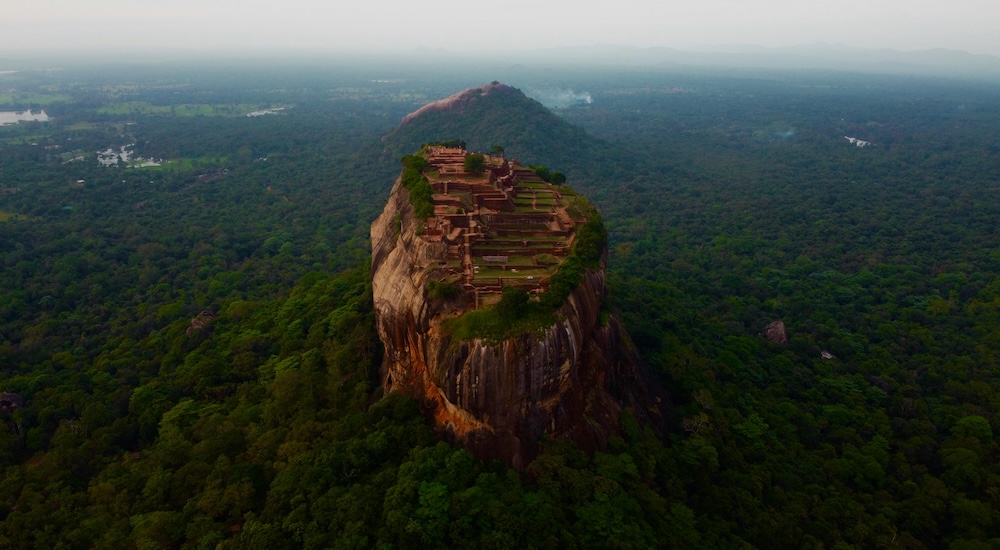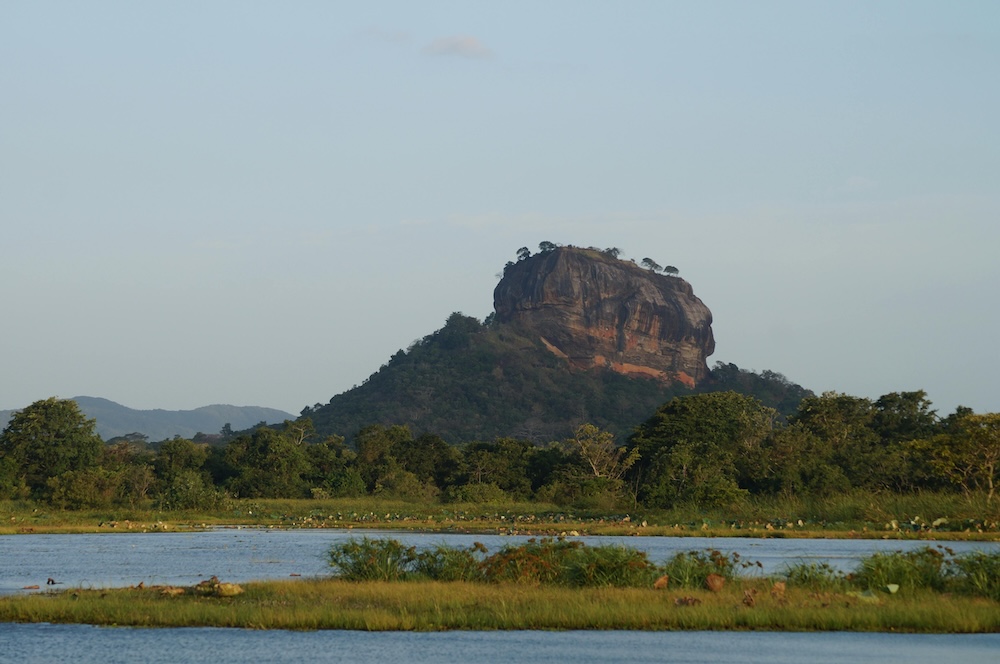Sigiriya is one of South Asia's most mysterious monuments. It rises sharply from the green plains of central Sri Lanka. This huge granite monolith, which rises 200 meters above the jungle canopy, hides a history that is much more complicated and mysterious than its famous 5th-century palace. There is a lot of evidence for King Kashyapa's reign, but there are also a lot of ancient stories, prehistoric settlements, and mythical kingdoms that make it hard for us to understand this UNESCO World Heritage site.
The Geological Wonder and Its Ancient Roots
Before people turned Sigiriya into a fortress, nature had already made a beautiful building. The rock is a huge column of hardened magma from a volcano that is no longer active. Over millions of years of erosion, it has become the steep-sided monolith we see today. This geological formation offered natural protection that would draw people to settle there for thousands of years.
Archaeological evidence indicates that the vicinity of Sigiriya was populated as early as 3000 BCE during the Mesolithic Period, with the Aligala rock shelter to the east of Sigiriya rock representing one of the earliest indicators of human habitation. There are many caves and rock shelters on the boulder-strewn hills around Sigiriya that show clear signs of being used by Buddhist monks and ascetics as early as the 3rd century BCE, long before King Kashyapa came.

Carved drip ledges around cave mouths and rock inscriptions recording the donation of shelters to the Buddhist monastic order are two ways that these early Buddhist settlements left their mark. This pre-Kashyapa history shows that Sigiriya was already known as a holy and important place hundreds of years before it became famous for its transformation.
Our ancestors lived in the area around Sigiriya between 10,000 and 20,000 years ago, which is amazing. However, the earliest dates we have from current research go back to about 5,000 BCE. Archaeologists found stone tools, grinding stones, and animal remains in the Aligala rock shelter. These are thought to be the remains of food eaten by the prehistoric people who lived there.
The Famous Link Between Ravana and Alakamandawa
The most interesting thing about Sigiriya's hidden history might be how it relates to ancient myths. Long before the 5th century, Sri Lankan folklore and other historical accounts called Sigiriya Alakamandawa (also known as Alakamanda or Akasa Maligawa, which means "Sky Palace").
Alakamanda was the beautiful palace of Kubera (also called Kuvera or Vaisravana), the god of wealth and king of the Yakshas, in Hindu mythology and the epic Ramayana. The Ramayana epic tells the story of how Ravana, Kubera's half-brother, overthrew him and took over Lanka. Some Sri Lankan traditions say that Sigiriya was this famous palace, which could mean that it is over 5,000 years old according to some interpretations.
The link to ancient myths goes beyond just stories. Local customs say that the Singhalese Yakkha Tribes called Sigiriya Alakamandawa, and that it was the palace of Kubera before Ravana took it over. The name Kubera is thought to come from the Sanskrit words Ku and Vira, which mean "Earth" and "Hero." Even today, the Sinhalese word "Kuwera" means "someone who has a lot of money."
People said that King Kashyapa lived as a "cult of Kuvera" in the "Alakamanda" palace at Sigiriya, which is on top of the rock. This implies that even in the 5th century, people knew that the site had mythological meaning and was linked to the famous god-king Kubera.
King Kashyapa's Change: A Historical Record and an Engineering Wonder
The most well-known part of Sigiriya's history starts with King Kashyapa I, who ruled from 477 to 495 CE. The old Sri Lankan book Culavamsa says that Kashyapa was the son of King Dhatusena and a woman who was not of royal blood. Kashyapa plotted with his uncle and army commander Migara to take power because he was not the rightful heir to the throne, which belonged to his half-brother Moggallana (son of the queen).
The historical account tells of a violent patricide: Kashyapa locked up his father and, in an attempt to get him to give up hidden treasures, killed him by walling him up alive. Moggallana fled to South India after this terrible act, promising to come back with an army to take back his rightful throne.
Kashyapa left the traditional capital of Anuradhapura and moved to the safer Sigiriya because he was afraid of what would happen next. He turned the rock into one of the most advanced fortresses and palace complexes in the ancient world in just 7 to 18 years (different sources give different numbers). This very short construction time makes people wonder if Kashyapa built from scratch or fixed up buildings that were already there, which supports ideas that he had an important role in architecture before.
The engineering feats that were done in such a short amount of time are mind-boggling. People said that King Kashyapa built Sigiriya as a rock fortress in seven years. During this time, there were huge building projects that included leveling the top of the 200-meter granite rock, moving millions of clay bricks to the top, building complex hydraulic systems, and making beautiful gardens and defensive structures.
The City in the Sky: A New Look at Alakamanda
King Kashyapa envisioned Sigiriya as a recreation of the mythological Alakamanda, the city of the gods, whether he was building on old foundations or starting from scratch. You can see this spiritual and architectural vision all over the complex.
People say that Kashyapa painted the rock white to make it look like a cloud, which made it look like a palace was floating in the sky. The advanced city planning used both symmetry and asymmetry to connect geometric human-made structures with the natural shapes of the area.
The site has three separate but connected garden systems that are some of the oldest landscaped gardens in the world:
Water Gardens: The western area has rectangular pools, winding streams, and complex fountain systems. These limestone plate fountains still work today, even in the rainy season. This shows that the hydraulic engineering used to make them was very advanced for the 5th century.
Boulder Gardens: These gardens used the natural landscape of boulders to make rock shelters that may have been built before Kashyapa's time.
Terraced Gardens: These gardens went up from the bottom to the top, showing great planning and engineering skill.
The hydraulic systems are very interesting. Water was moved through channels carved into the rock by underground water conduits. A system that used gravity and pressure brought water all the way up to the palace at the top, which was 200 meters above sea level. The system has things like underground pipes, surface canals, and devices that make pressure to control and change the flow of water. Some of these systems are still used to water the area today.
The Mysterious Frescoes: Are They Divine Maidens or Royal Court?
The well-known frescoes on the western rock face are one of the most interesting mysteries about Sigiriya. These paintings showed more than 500 women and originally covered about 5,600 square meters in a continuous band around the rock's waist. There are only 19 paintings left today, and they are in a protected area about 100 meters above the ground.

For more than a hundred years, people have been arguing about who these heavenly maidens are and what they mean. People often call these figures "Sigiriya Maidens" or "Apsaras," which means "celestial nymphs." They are shown in graceful, stylized poses, either holding flowers or doing other symbolic things. There are many ideas about who they are:
Apsaras or Celestial Nymphs: Many historians think the figures are apsaras, which are heavenly beings from Hindu and Buddhist mythology who live in Indra's heaven. The figures are cut off at the waist by regular clouds, which is a common way for artists to show heavenly beings.
Royal Court: Some people think that the paintings show Kashyapa's harem of more than 500 beautiful concubines, or maybe his daughters and court ladies. This interpretation is supported by the royal bearing and the intricate jewelry with gems.
Cultural and Ethnic Representations: Some interpretations say that the blue ladies stand for different tribes, such as the Yakka, Naga, Deva, and Gandhabba tribes.
These paintings were made using the true fresco technique (buon fresco), which means that pigments were mixed with water and then applied to wet lime mortar. They had to be done quickly and without mistakes. The bright colors came from natural mineral-based pigments. For example, reds came from iron oxide, whites from chalk or lime, yellows from ochre, and blacks from charcoal. The fact that the paintings have lasted for more than 1,600 years shows how good the artists were and how well they were protected by their location.
The Mirror Wall: Old Graffiti and Medieval Voices
The Mirror Wall runs next to the frescoes. It was once polished so well that the king could see his own reflection in it. Between the 8th and 10th centuries, more than 1,000 people wrote on this wall, making it one of the oldest examples of Sinhalese poetry and prose.
These carvings, called Sigiri Graffiti or Kurutu Gee, show that Sigiriya was a tourist spot more than a thousand years ago. The wall has the names of more than 850 people, including 12 women. The verses show how much they love the frescoes and the beauty of the rock, giving us a unique look at medieval Sri Lankan language, culture, and taste.
There are more than 1,000 unique words from Sinhala, Tamil, and Sanskrit in the graffiti, making it a very useful language resource. Many of them are very literate and have a deep love of art and poetry. Visitors often choose one woman as the subject of their verse, focusing on how mysterious or distant she is.
The Lion's Gate: A Sign of Power and Mystery
One of Sigiriya's most impressive features used to be the huge lion statue carved from living rock that stood at the northern entrance to the summit. The entrance stairway went between its paws and into its mouth. The word "Sigiriya" comes from the Sinhala word "Sinhagiri," which means "Lion Rock."
During digs in 1898, British archaeologist H.C.P. Bell found the two huge lion paws. These paws are as big as a person, so the whole lion sculpture would have been huge and scary, showing how powerful King Kashyapa was. The lion's head has long since fallen off, but the paws and the original grooves and steps cut into the rock are still there.
The Time of the Buddhist Monastery and the Middle Ages
After Kashyapa died in 495 CE, Moggallana moved the capital back to Anuradhapura and turned Sigiriya into a group of Buddhist monasteries. For almost 800 years, the site served as a place for meditation and religious study. It did so until the 13th or 14th century.
During this time, a lot of the less religious parts of Kashyapa's palace were taken out or left to rot. The graffiti on the Mirror Wall shows that people couldn't get to the site for about a hundred years after Sigiriya was abandoned and turned into a monastery. The monastery may have made extra money by letting pilgrims visit the site during hard times, which is how the large collection of medieval inscriptions came to be.
Finding Again and New Ways of Looking at Archaeology
The West found Sigiriya again in 1831 when Major Jonathan Forbes of the British Army found it while traveling from Polonnaruwa to Kandy. Forbes became friends with George Turnour, who had translated old Buddhist texts that talked about Kashyapa and his palace. They decided to look for it.
Forbes' memoir talks about "the rock of Sirigi [sic], . . . frowning defiance over the scanty fields and the far-extending forest of the surrounding plain." As he got closer, he could see platforms and galleries carved into the rock. However, his first trip was cut short because he didn't have enough supplies and people in the area were scared of demons on the rock.
In 1853, two young people who worked for the Ceylon Civil Service, A.Y. Adams and J. Bailey was the first person to reach the top of the rock using rope ladders and a different path than Forbes. H.C.P. Bell started the first real archaeological dig at Sigiriya in the 1890s.
In 1982, the site was named a UNESCO World Heritage Site because it has great universal value. The inscription mentioned the ruins of the capital that the parricidal King Kassapa I (477–95) built. They are on the steep slopes and at the top of a granite peak that is about 180m high.
Unsolved Mysteries and Other Theories
Even after a lot of research, there are still some things we don't know about Sigiriya:
Construction Timeline: Was it possible for Kashyapa's engineers to finish such a complicated building in only 7 to 18 years? Some researchers think that this question means that there was already a lot of infrastructure before his reign, which could support the Alakamanda legends.
Advanced Hydraulic Technology: The way the water management systems work seems very advanced for the 5th century. Some of these aqueducts still work 1,500 years later, and modern engineers are still confused by them.
Hidden Chambers: New technologies like LiDAR scanning and ground-penetrating radar are still finding new structures and spaces in and around the rock that were not known before. The mystery of possible "Sigiriya secret chambers" is made even more interesting by stories about hidden treasures and secret escape routes.
Megalithic Construction Techniques: The accuracy of some parts of the building, especially the granite water tank at the top and the carvings, is similar to megalithic construction techniques used all over the world. The water tank was 30 meters long, 23 meters wide, and 2.5 meters deep. To make room for it, about 3,500 tons of granite had to be taken out.
The Living Legend
Today, Sigiriya is a place where history, mythology, and national identity all come together. For a lot of Sri Lankans, it is more than just an archaeological site; it is a sign of ancient knowledge, engineering skill, and cultural sophistication.
The fortress is still a topic of discussion among archaeologists, historians, and other researchers. It seems like every new study raises as many questions as it answers. There are many stories about Sigiriya, such as the patricidal king, the legendary demon king Ravana, the Buddhist monastery, and the pleasure palace. These stories show how hard it is to understand the distant past with only a little evidence.
Recent research has concentrated on the sustainable features of the Sigiriya water system. The effective utilization of rainwater harvesting, the gravity-fed mechanism, and the incorporation with the natural terrain exemplify principles of sustainable water management that remain profoundly pertinent in contemporary times.
Conclusion: Somewhere Between History and Mystery
We may never know the whole story of Sigiriya. The archaeological evidence confirms that there was a very advanced royal complex in the 5th century. The old texts and inscriptions tell stories of palace politics, military strategy, and building plans. There are stories and legends about mythical kingdoms, divine architects, and links to epic histories that go back thousands of years.
These different ways of looking at Sigiriya don't make it less important; they make it more important. Whether Kashyapa built on ancient foundations linked to the mythical Alakamanda, whether advanced knowledge came from faraway places, or whether his engineers did amazing things on their own, all of these things show how smart and ambitious people can be.
The frescoes still look down from their old alcove, the Mirror Wall still holds the voices of medieval visitors, and the lion's paws still guard the way to the top. Each part of the site adds to the fact that it can't be easily put into a box. Instead, it's a place where the lines between history, legend, and mystery are intentionally blurred.
Sigiriya is a reminder to both modern tourists and researchers that the past is never as simple as our histories make it seem. There are deeper stories, older traditions, and mysteries that may never be fully solved behind every documented fact. In this way, the most valuable thing about Sigiriya is not what we already know about it, but what is still hidden and waiting to be found or kept alive in the world of legend.
The ongoing archaeological investigations, which use cutting-edge tools like LiDAR scanning and ground-penetrating radar, keep finding new things about this ancient wonder. As we learn more about Sigiriya's complex hydraulic systems, its possible links to ancient settlements, and its place in ancient mythology, we get closer to understanding how big of a deal this was for human civilization.
